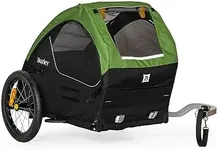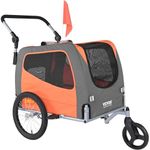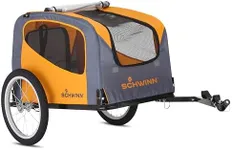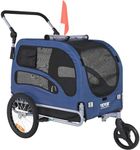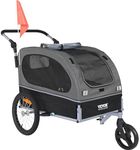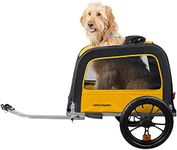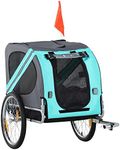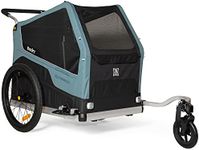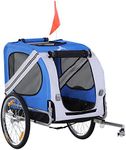Buying Guide for the Best Dog Bicycle Trailer
Choosing a dog bicycle trailer is all about ensuring your pet’s safety, comfort, and enjoyment while making your rides together as smooth as possible. Before you start shopping, think about your dog’s size, how often you’ll use the trailer, and the types of routes you’ll be riding on. The right trailer will keep your dog secure, be easy for you to handle, and fit your lifestyle. Understanding the key features will help you make a smart choice that both you and your furry friend will appreciate.Weight CapacityWeight capacity refers to the maximum weight the trailer can safely carry, including your dog and any extra items you might bring along. This is important because overloading a trailer can make it unstable or unsafe. Trailers are usually divided into small (up to 40 lbs), medium (40-70 lbs), and large (over 70 lbs) categories. To pick the right one, weigh your dog and consider their full-grown size if they’re still a puppy. Always choose a trailer with a weight limit higher than your dog’s weight to ensure safety and comfort.
Interior DimensionsInterior dimensions describe the space inside the trailer where your dog will sit or lie down. This matters because your dog needs enough room to turn around, sit, and lie comfortably. Trailers come in various sizes, so check the length, width, and height. For small dogs, a compact trailer is fine, but larger dogs need more space. Measure your dog from nose to tail and from the ground to the top of their head, then compare these measurements to the trailer’s interior. Choose a trailer that gives your dog a little extra space to move.
Hitch AttachmentThe hitch attachment is the part that connects the trailer to your bicycle. It’s important because a secure and easy-to-use hitch keeps the trailer stable and makes attaching and detaching simple. There are basic clamp-on hitches and more advanced quick-release systems. If you plan to attach and remove the trailer often, look for a quick-release hitch. Make sure the hitch is compatible with your bike’s rear axle or frame, and check if it allows for smooth turning and doesn’t interfere with your bike’s movement.
SuspensionSuspension refers to the system that absorbs bumps and vibrations from the road, making the ride smoother for your dog. This is especially important if you’ll be riding on rough or uneven surfaces. Some trailers have no suspension, which is fine for smooth city paths, while others have built-in suspension for off-road or bumpy rides. If your dog is older, has joint issues, or you plan to ride on trails, choose a trailer with good suspension to keep your pet comfortable.
Ventilation and WindowsVentilation and windows are features that let air flow through the trailer and allow your dog to look outside. Good ventilation keeps your dog cool and comfortable, especially on warm days. Trailers usually have mesh panels or windows on the sides and front. For short rides or cooler climates, basic ventilation is enough, but for longer rides or hot weather, look for trailers with large mesh areas and multiple windows. This will help your dog stay happy and relaxed during the ride.
Entry and Exit PointsEntry and exit points are the doors or openings that let your dog get in and out of the trailer. This is important for ease of use, especially if your dog is large or has mobility issues. Some trailers have a front door, some have a rear door, and others have both. If your dog is older or less agile, a low, wide entry is best. Think about how your dog likes to enter spaces and choose a trailer with doors that make it easy for them.
Foldability and StorageFoldability refers to how easily the trailer can be collapsed for storage or transport. This matters if you have limited space at home or need to take the trailer in your car. Some trailers fold flat in a few steps, while others are more rigid. If you’ll be storing the trailer in a small area or transporting it often, look for a model that folds compactly and is easy to set up and take down.
Safety FeaturesSafety features include things like reflectors, safety flags, interior leash attachments, and sturdy construction. These features help keep your dog visible and secure while riding. Reflectors and flags make the trailer more noticeable to cars and other cyclists, while interior leashes prevent your dog from jumping out. If you’ll be riding in traffic or low-light conditions, prioritize trailers with high-visibility features and strong, reliable construction.
